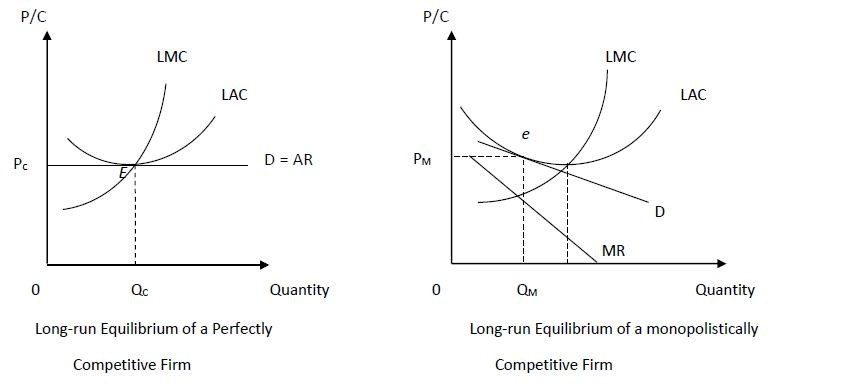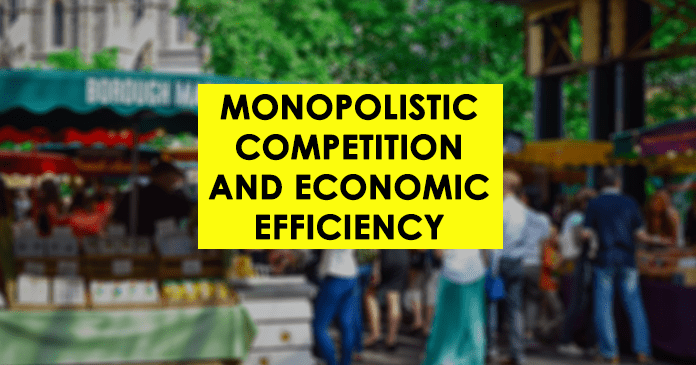Monopolistic Competition and Economic Efficiency will be discussed in this post.
We’ve covered the following topics in our monopolistic competition post series.
- Monopolistic competition assumptions
- Short-run equilibrium of a firm under monopolistically competitive
- Long-run equilibrium of a firm under monopolistically competitive
Read the previous articles to gain a better understanding of monopolistic competition before reading this one.
It is argued that a competitive market is more appropriate because it is more economically efficient than other market structures. Monopoly competition is in some ways similar to a competitive market.
But is it an efficient market structure? To answer this question, let us compare the long-run equilibrium of monopoly competition with that of perfect competition.
Perfectly Competitive Firm VS Monopolistically Competitive Firm

- At the equilibrium of a monopolistically competitive firm MC=MR and AC=P, but P > MC.
- At the equilibrium, MC=P in a perfectly competitive firm.
MC – Marginal Cost
MR – Marginal Revenue
AC – Average Cost
P – Price
Under monopolistic competition, as a result of these different equilibrium conditions, the price will be higher and the quantity will be lower than in perfect competition.
However, profit will be just normal in the long run in both firms.
Although the price of a perfectly competitive firm equals the minimum AC (perfect competition equilibrium occurs at the minimum point of LAC), this will never happen in monopolistic competition because the tangency of LAC and demand curve occurs necessarily at the falling part (where left to the minimum LAC) of LAC curve.
The demand curve of a monopolistic competition will never touch the minimum point of the LAC curve because it is not a straight line parallel to the horizontal axis as in perfect competition.
Therefore always price will be higher than the minimum average cost, and production cost will be higher than in pure competition. Moreover, there is a selling cost in addition to the production cost in the monopolistic competition. This is another reason for the total cost (and price) to be higher.
Another criticism that has arisen against monopolistic competition is that it operates with excess capacity. In general, connecting the output with the lowest point of the LAC curve is considered to be the most efficient output level.
In the perfect competition, no excess capacity and firms are operating at the minimum point of LAC hence, resource utilization of the economy is said to be most efficient.
Under monopolistic competition, there is an unutilized capacity as such the resources utilization is inefficient. Consumers suffer as a result of inefficiency.
Is monopolistic competition a socially unfavorable market structure that needs to be controlled?
In reality, the answer is no generally! Because,
1. The monopoly power of firms in monopolistically competitive markets is small. In most cases, enough firms compete with brands that are sufficiently sustainable for each other. As a result, no single firm has a significant monopoly. Excess capacity will be small when the firms’ demand curves are fairly elastic.
2. Any inefficiency must be balanced against a key benefit of monopolistic competition: product variety. In fact, product differentiation is a response by firms to differences in consumer preferences.
The option to pick from a large range of competing items and brands that differ in a variety of ways is highly valued by most consumers. The benefits of product diversity can be large, outweighing the inefficiency costs associated with demand curves that slope downward.
Further Reading
Perfect Competition: Definition, Graphs, short run, long run
Monopolistic Competition Equilibrium| Long-run, Short-run
Top 5 characteristics of an oligopoly
Monopoly – Price discrimination: Types, Degrees, Graphs, Examples
Different Types of Monopolies| 7 Types
Monopolistic Competition and Economic Efficiency
Perfect Competition: Definition, Graphs, short run, long run
Monopolistic Competition Assumptions [Updated]
I’m looking forward to hearing from you. So, please comment in the section below.


